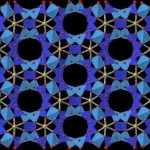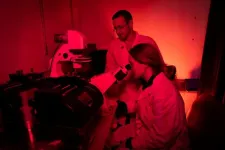(Press-News.org) A whitish, grey patch that sometimes appears in the night sky alongside the northern lights has been explained for the first time by researchers at the University of Calgary.
The article, which was published on Dec. 30 in the journal Nature Communications, explores a “structured continuum emission” that’s associated with aurora borealis.
“You’d see this dynamic green aurora, you’d see some of the red aurora in the background and, all of a sudden, you’d see this structured – almost like a patch – grey-toned or white toned-emission connected to the aurora,” says Dr. Emma Spanswick, PhD, lead author on the paper and an associate professor with the Department of Physics and Astronomy in the Faculty of Science.
“So, the first response of any scientist is, ‘Well, what is that?’”
Spanswick says the white patch has been referenced in scientific papers before, but it has never been explained.
Her team’s paper concludes it’s “most certainly a heat source” and says it suggests that the aurora borealis are more complex than previously thought.
Spanswick says the discovery was made possible because an advancement in camera technology allows both amateur photographers and scientists to see true colour images of the night sky.
“Everyone has noticed the advancement in digital photography. Your cellphone can now take pictures of the aurora,” she says. “That has flowed to the commercial sensor market now.
“Those types of sensors can now be found in more commercial, more robust sensors that we would use in science.”
The team’s research came after there was a renewed interest in continuum emission with the discovery and observations of the long, glowing ribbon of purple light known as STEVE – or Strong Thermal Emission Velocity Enhancement.
“There are similarities between what we’re seeing now and STEVE,” explains Spanswick. “STEVE manifests itself as this mauve or grey-toned structure.
“To be honest, the elevation of the spectrum between the two is very similar but this, because of its association with dynamic aurora, it’s almost embedded in the aurora. It’s harder to pick out if you were to look at it, whereas STEVE is separate from the aurora – a big band crossing the sky.”
The latest research is also significant because it includes three UCalgary students, including undergraduate Josh Houghton who was initially hired as an intern on the project.
“I was still learning things at the time,” he says. “I had just started my internship, and I very quickly got involved. It’s just very, very cool.”
Spanswick says Houghton did a lot of the analysis on the research, which led to his participation in the Nature paper as an undergraduate student.
“He’s had one heck of an internship experience,” she says.
Houghton will continue the research as part of his undergrad honours thesis, before taking on his master’s degree at UCalgary next year.
The research was made possible by the Transition Region Explorer (TREx), which is a UCalgary project jointly funded by the Canadian Foundation for Innovation, the Government of Alberta and the Canadian Space Agency.
The TREx RGB and Spectograph instruments are operated and maintained by Space Environment Canada with the support of the Canadian Space Agency through its Geospace Observatory (GO) Canada initiative.
END
‘What is that?’ UCalgary scientists explain white patch that appears near northern lights
Improved camera technology helps capture true colour images of the night sky
2025-01-10
ELSE PRESS RELEASES FROM THIS DATE:
How many children use Tik Tok against the rules? Most, study finds
2025-01-10
How many children use Tik Tok against the rules? Most, study finds
As the U.S. Supreme Court considers whether Congress can ban Tik Tok, new research highlights the health risks that top social media platforms pose to children.
Most 11- and 12-year-olds use Tik Tok and other social media despite the platforms’ age restrictions, and many show signs of addiction to social media, a new UC San Francisco study found.
Tik Tok, Instagram, YouTube, and Snapchat require users to be at least 13 years old to have an account. But the study found that a majority of 11- and 12-years olds across the country have accounts on the platforms, ...
Scientists find out why aphasia patients lose the ability to talk about the past and future
2025-01-10
An international team of researchers, including scientists from the HSE Centre for Language and Brain, has identified the causes of impairments in expressing grammatical tense in people with aphasia. They discovered that individuals with speech disorders struggle with both forming the concept of time and selecting the correct verb tense. However, which of these processes proves more challenging depends on the speaker's language. The findings have been published in the journal Aphasiology.
Aphasia is a severe speech disorder, often resulting ...
Tickling the nerves: Why crime content is popular
2025-01-10
Consumers of content about serial killers watch and read it to experience intense emotions that are often lacking in everyday life and to understand the reasons that drive people to commit crimes. However, such content does not contribute to increased aggression. These conclusions were drawn by sociologists from HSE University. The results of their study have been published in Crime, Media, Culture: An International Journal.
Research on the modern media market shows that content about serial killers is popular worldwide, spanning films, true crime series, short videos, and written materials detailing crimes, investigations, ...
Intelligent fight: AI enhances cervical cancer detection
2025-01-10
A cutting-edge article is paving the way for a transformation in cervical cancer screening, leveraging artificial intelligence (AI) to enhance detection accuracy and efficiency. This pioneering research explores the application of AI in medical image interpretation, marking a significant leap in cervical cancer management and prevention. With the aid of deep learning algorithms, the study seeks to address the critical need for more effective screening tests, especially in low- and middle-income countries where traditional methods often fall short. This innovative approach promises to alleviate the global burden of cervical cancer by improving ...
Breakthrough study reveals the secrets behind cordierite’s anomalous thermal expansion
2025-01-10
Cordierite, a remarkable mineral familiar to many as the material behind heat-resistant pizza stones, exhibits an unusual ability to resist changes in size despite significant temperature fluctuations. While widely used in diverse applications from automotive catalytic converters to high-temperature industrial processes, the fundamental reasons behind this anomalous thermal behaviour have remained largely unexplained. A new study, led by researchers at Queen Mary University of London and published in Matter, now provides the first comprehensive explanation, with profound implications for the design and development of advanced materials.
"Modern society demands materials that ...
Patient-reported influence of sociopolitical issues on post-Dobbs vasectomy decisions
2025-01-10
About The Study: Nearly one-third of survey participants indicated sociopolitical issues influenced their vasectomy decision, despite the fact these policies have targeted female reproductive policy. These patient-reported motivations are consistent with recent research using administrative data that found a rise in vasectomy procedure volume after the Dobbs decision.
Corresponding Author: To contact the corresponding author, Kathleen Hwang, MD, email kathleen.hwang@pennmedicine.upenn.edu.
To access the embargoed study: Visit our For The Media website at this link https://media.jamanetwork.com/
(doi:10.1001/jamanetworkopen.2024.54430)
Editor’s ...
Radon exposure and gestational diabetes
2025-01-10
About The Study: This cohort study suggests that higher radon exposure is associated with greater odds of gestational diabetes in nulliparous pregnant individuals. Further studies are needed to confirm the results and elucidate the underlying mechanisms, especially with individual-level residential radon exposure assessment.
Corresponding Author: To contact the corresponding author, Ka Kahe, MD, ScD, email kk3399@columbia.edu.
To access the embargoed study: Visit our For The Media website ...
EMBARGOED UNTIL 1600 GMT, FRIDAY 10 JANUARY 2025: Northumbria space physicist honoured by Royal Astronomical Society
2025-01-10
Dr John Coxon, esteemed member of Northumbria University’s world-leading Solar and Space Physics research group, has been recognised by the Royal Astronomical Society for his work.
Dr Coxon is a Science and Technology Facilities Council (STFC) Ernest Rutherford Fellow at Northumbria University who has garnered international recognition for his research into understanding the Sun's influence on Earth's space environment.
It has today been announced that he has been awarded the with the prestigious ...
Medicare rules may reduce prescription steering
2025-01-10
Weill Cornell Medicine researchers have found that pharmacy benefit managers (PBMs)—organizations that negotiate access to medicines for most patients in the United States—steer patients to use their own pharmacies. However, these pharmacies appear less used in Medicare than in other market segments. These PBMs are part of integrated health care conglomerates that own insurance companies and pharmacies, which may create conflicts of interest.
The study, published Jan. 10 in JAMA Health Forum, found that in 2021 a third of all Medicare Part D pharmacy spending and almost 40% of specialty drug spending within Medicare Part D was through pharmacies owned by the four largest PBMs: ...
Red light linked to lowered risk of blood clots
2025-01-10
Humans and mice exposed to long-wavelength red light had lower rates of blood clots that can cause heart attacks, lung damage and strokes, according to research led by University of Pittsburgh School of Medicine and UPMC surgeon-scientists and published today in the Journal of Thrombosis and Haemostasis.
The findings, which need to be verified through clinical trials, have the potential to reduce blood clots in veins and arteries, which are leading causes of preventable death worldwide.
“The light we’re exposed to can change our biological processes and change ...
LAST 30 PRESS RELEASES:
Tracing the quick synthesis of an industrially important catalyst
New software sheds light on cancer’s hidden genetic networks
UT Health San Antonio awarded $3 million in CPRIT grants to bolster cancer research and prevention efforts in South Texas
Third symposium spotlights global challenge of new contaminants in China’s fight against pollution
From straw to soil harmony: International team reveals how biochar supercharges carbon-smart farming
Myeloma: How AI is redrawing the map of cancer care
Manhattan E. Charurat, Ph.D., MHS invested as the Homer and Martha Gudelsky Distinguished Professor in Medicine at the University of Maryland School of Medicine
Insilico Medicine’s Pharma.AI Q4 Winter Launch Recap: Revolutionizing drug discovery with cutting-edge AI innovations, accelerating the path to pharmaceutical superintelligence
Nanoplastics have diet-dependent impacts on digestive system health
Brain neuron death occurs throughout life and increases with age, a natural human protein drug may halt neuron death in Alzheimer’s disease
SPIE and CLP announce the recipients of the 2025 Advanced Photonics Young Innovator Award
Lessons from the Caldor Fire’s Christmas Valley ‘Miracle’
Ant societies rose by trading individual protection for collective power
Research reveals how ancient viral DNA shapes early embryonic development
A molecular gatekeeper that controls protein synthesis
New ‘cloaking device’ concept to shield sensitive tech from magnetic fields
Researchers show impact of mountain building and climate change on alpine biodiversity
Study models the transition from Neanderthals to modern humans in Europe
University of Phoenix College of Doctoral Studies releases white paper on AI-driven skilling to reduce burnout and restore worker autonomy
AIs fail at the game of visual “telephone”
The levers for a sustainable food system
Potential changes in US homelessness by ending federal support for housing first programs
Vulnerability of large language models to prompt injection when providing medical advice
Researchers develop new system for high-energy-density, long-life, multi-electron transfer bromine-based flow batteries
Ending federal support for housing first programs could increase U.S. homelessness by 5% in one year, new JAMA study finds
New research uncovers molecular ‘safety switch’ shielding cancers from immune attack
Bacteria resisting viral infection can still sink carbon to ocean floor
Younger biological age may increase depression risk in older women during COVID-19
Bharat Innovates 2026 National Basecamp Showcases India’s Most Promising Deep-Tech Ventures
Here’s what determines whether your income level rises or falls
[Press-News.org] ‘What is that?’ UCalgary scientists explain white patch that appears near northern lightsImproved camera technology helps capture true colour images of the night sky




